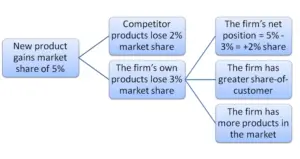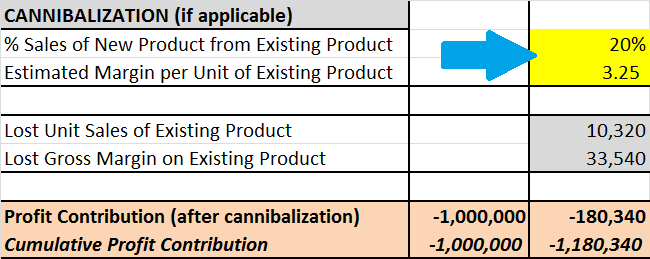Contents
The Potential Impact of Product Cannibalization in Marketing
Product cannibalization is when the firm’s new product “wins” a proportion of its sales (market share) from the firm’s other existing products – that is, the new product “eats away” the market share of the firm’s other products.
We must take product cannibalization into account in our forecasts because the prime goal of the sales and profitability forecasts is to determine the future position of firm/brand based upon the inclusion of this new product into their product mix.
It should NOT be the financial evaluation of a single product in isolation.
Product line extensions are more concerning for cannibalization impact
Product line extensions are a relatively common form of new product. Strong brands tend to have a very positive following and a supportive customer base. Therefore, it becomes quite attractive for them to develop and expand the firm’s existing product line and try to increase share of customer.
However, the consumer does not have an endless desire/need for the firm’s products and will sometimes trade-off between offerings from the same brand/firm.
A quick example
Let’s use the example of a manufacturer of cookies that has a large market share. Let’s assume they sell three varieties/flavors of their best-selling chocolate cookies and they plan to bring out a fourth version/flavor.
Their marketing goals are to continue to build brand, strengthen brand loyalty, increase share of customer, increase retailer space, defend/attack competitors, and grow overall sales volumes. And a new product line extension is likely to help them achieve these worthy marketing goals.
However, if the new flavor of cookies (their product line extension) was to achieve a market share of 5% and sales of 1 million units for example – then it is highly unlikely that all of those sales have been switched from competitive brands.
In reality, a reasonable proportion of those sales would have been cannibalized from sales of their three existing flavor varieties (reducing the profitability of those existing products).
But as you can see in the diagram, the firm still has a net benefit overall and is in a stronger competitive position as a result.
Incorporating Cannibalization into a Marketing Forecast
As you can see from the above discussion, it is important to view the new products financial impact on the whole firms/brands product range, not just look at the new product in isolation.
As a result, particularly for product line extension products, the impact of product cannibalization must be considered in the financial forecasts.
This calculation has been built-in as an optional section into the free ATAR Excel spreadsheet available on this website.
As you can see, the only two additional inputs required to generate the revised financial forecasts are: the unit margin of the products likely to be cannibalized (that is, their price less costs) and the percentage of the new product sales likely to be generated from existing products.
You should note that the bottom summary of the ATAR template, which also incorporates the financial metrics, automatically builds in the impact of the product cannibalization.
If product cannibalization is unlikely then you will need to set these two inputs to zero and there will be no product cannibalization taken into account in the ATAR forecast.
Some Product Cannibalization Examples
Apple’s iPhone cannibalizing iPod sales:
When Apple introduced the iPhone, it impacted sales of its iPod line. Customers who previously purchased iPods for music playback started opting for the more versatile iPhone, which offered music playback along with various other features.
Coca-Cola’s introduction of Coke Zero cannibalizing Diet Coke sales:
When Coca-Cola launched Coke Zero, a zero-calorie soft drink targeted towards men, it attracted a portion of consumers who would have otherwise purchased Diet Coke. The introduction of Coke Zero resulted in some cannibalization of Diet Coke sales.
McDonald’s McChicken sandwich cannibalizing sales of other chicken products:
McDonald’s introduced the McChicken sandwich as a new product offering. While it attracted new customers and increased overall chicken sandwich sales, it also cannibalized sales of other chicken-based menu items, such as the Chicken McNuggets or the McChicken Deluxe.
Amazon’s Kindle cannibalizing physical book sales:
With the introduction of the Kindle e-reader, Amazon experienced cannibalization of physical book sales. Customers who previously purchased printed books began opting for digital versions, leading to a decline in the sales of traditional books.
Nike’s Air Max line cannibalizing sales of other Nike shoe models:
Nike’s Air Max line, known for its distinctive visible air cushioning, became highly popular among customers. However, as the Air Max line gained popularity, it started cannibalizing sales of other Nike shoe models within the same price range, as some customers switched their preference to Air Max shoes.
Find more: Sales Cannibalization Examples
Related Topics


